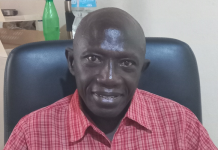When news of the pandemic greeted the world toward the latter part of 2019, many people did not think that the virus would be potent for the several long months it has been with us. This Op-Ed is not an analysis on the impacts of the pandemic in human lives. The impacts of the pandemic are evident and felt throughout the world, albeit, with varying degrees of viciousness.
It is a reaffirmation of human resilience in the face of a pandemic whose end cannot be predicted.
I am fully aware of the education ministry’s efforts to continue providing education during the pandemic. While I have doubts in the efficacy and effectiveness of the number of plans to see it through, I have no illusion about the laudability of the efforts. Thus, this article’s goal is not to throw the hard work of our county’s dedicated educators under the rug, but rather, to add to the list of potential options the ministry can, perhaps, explore to speed up the process of getting our children back to schools in a safe manner when our Covid-19 curve is flattened.
As someone with a background in Educational Leadership and Policy Studies, I am obligated by my duty as a citizen to share my thoughts on how to reorganize our learning architecture to deal with the pandemic. At this critical juncture, leadership is needed to creatively chart a path for our young people in The Gambia to continue their education and a concerted effort is indispensable in that quest.
Our children’s extended stay at home and little to no contact with their school curricula is a chaotic learning crisis by and itself ! In fact, research has established that students tend to experience a learning loss in the summer and particularly the ones who do not come from homes that provide a supportive learning environment to help retain the lessons they have learned or to build on them during summer school break. In The Gambian context, students mostly have three months or less summer holidays and the summer loss/slide syndrome is acutely a common experience among students especially the ones from the low socio-economic status. As a former school teacher in The Gambia, I know that summer slide first-hand. Using the summer learning loss as an example, it is relevant to ponder on the question of how much loss to learning from the school closure has occurred in the Gambia especially, considering the fact that our schools have been more or less closed since March 18th? The problem is not only about the learning loss due to the indefinite break, but also the fact that plans to safely reopen schools for the 2020-2021 academic year are currently hanging in the balance.
The impact of the learning loss may not be felt immediately but it is worrisome for several reasons. For many Gambian school children, staying at home means that they are missing out on lessons, camaraderie and the healthy environment of school where discipline and scholastics is nurtured and nourished. The learning loss will have devastating consequences on our nation’s future. Not just in terms of the quality of our human capital but also in terms of its capacity and productivity- that is if plans are not put in place to ameliorate the growing loss.
Understandably, organizing for education cannot happen in the same manner and space as during the time when our lives were normal. To wit : The Gambia is not alone in this process of figuring out what works for education during such unusual times. All the same, Cloud Learning has become en vogue for countries that have the required technological capability. Unfortunately, The Gambia is not one of those technologically advanced countries, but notwithstanding, our nation is well positioned to hone our adaptive resilience by putting our creative faculties to work.
The education ministry has intervened with continuity plans when schools closed down through the implementation of Television & Radio (T&R) instructions. It is hard to empirically assess the impact of that intervention on students’ learning outcomes given the brevity of the experiment. However, it is common knowledge that in The Gambia, many students do not have access to the technology for receiving instructions via TV and radio stations, and even if they do, having to be schooled at home adds to the mix of other constraining factors that limit their effective participation in that learning platform. For instance, girls may be inundated with household chores that compete with their time to participate in T&R learning. Boys may be distracted by social activities organized by their peers in the neighborhood such as football matches etcetera. Given that the results to show for the T&R learning experiment may not be quite substantial, it appears that the education ministry has decided to suspend, and rightly so, that plan and thus the hiatus we are currently experiencing in the search for a more realistic and meaningful alternative to the T&R learning.
Rather than keeping children at home and suspending their education indefinitely, I suggest that we consider REDUCING INSTRUCTIONAL TIME and DIVIDE STUDENTS INTO MANAGEABLE GROUPS to tackle the problem of inadequate school infrastructure that impedes the application of social distancing in our crowded classrooms.
Below I explicate that process.
First: class sizes vary across Gambian schools but the average class size by modest estimation is forty- fifty students for public elementary schools in urban areas. Students do have at least 4-5 hours of instructional time during regular school days and that is the case of both the morning and afternoon shifts. Since it will be unrealistic to sit every of those fifty students on a chair and desk individually, and to have them sit six feet apart in the classroom, students can be divided into two groups of 20-25 students. Each group can have two hours of TARGETED instructional time during which a subject or two is taught. Teachers will focus their class lessons and related activities on the core curriculum and give assignments to students to be completed at home. The model can be applied across the different grades of the lower, upper basic and senior secondary schools.
The reason why the suggested idea is particularly important is that it can reconnect students who have already lost touch with their schooling with their teachers and thus renew their interest in it. Additionally, although students will not be able to learn as much as they did during the pre-Coronavirus school days when the average instructional time was five hours, they will, without a doubt, benefit from the instructions. Students will also have more contact hours with their teachers in a school setting where their learning is supervised, and will approach their education more seriously than when they are left at home to independently learn via television and radio programs. Also, children can be formally educated about the Coronavirus and how to protect themselves and other people- a necessary education during this time.
Second : in consultation with the ministry of health, schools can be advised on the steps to follow for safe re-opening. The ministry of education and in collaboration with Parent-Teacher Associations (PTAs) can discuss sharing responsibility for buying school supplies such as hand-sanitizers, reusable face masks for students whose parents cannot afford face masks and other indispensable logistics for keeping schools safe and clean.
Third: the collaboration of school teachers is crucial in the successful implementation of the idea. Teaching four groups of students in the case of double-shift school teachers may be overwhelming. However, for the second sessions, teachers will be repeating the lessons they had with the first group and that may simplify the process of going through the lessons planned smoothly.
As with all things experimental, the proposed plan may not be perfect and therefore will require tweaking along the way. However, it is a realistic and low-cost measure. It will reduce the number of students who will congregate in schools at the same time and holding two sessions during the school days for both the morning and afternoon shifts will allow for social distancing possibilities even outside of the classrooms.
Gambian educators are dedicated and hardworking. It is needless to say that many of our nation’s teachers have missed their students and colleagues. If they are encouraged more, their collaboration in the suggested plan will be effective.
Reducing the instructional time and grouping students into small and manageable groups that allow for social distancing in schools is more plausible than the plan of having students take turns during the week for attending school and which is what the ministry will roll out in September- news I have heard through the grapevine. Students who attend school only two days during the week, even if receiving more instructional time, are more likely disengaged from their learning than the ones who attend school every day because they will not have the constant guidance of their teachers to ensure the timely completion of school related tasks.
Our country stands to benefit greatly from connecting our schoolchildren with classrooms more than with our streets. Covid-19 has tested everything we know about living a normal life, but our adaptive resilience can help us live through it without having to put our lives on hold. This too shall pass; it shall be well!
Haddy Njie
Raleigh, NC
USA




















